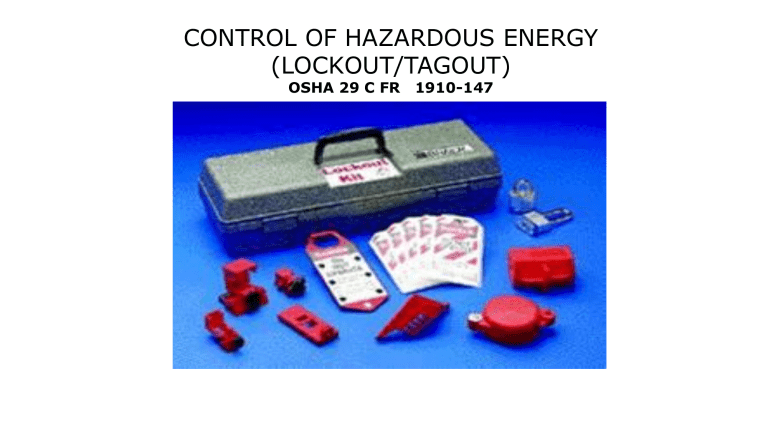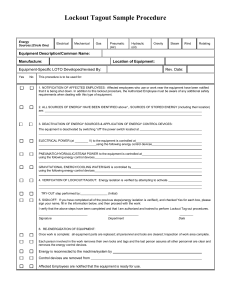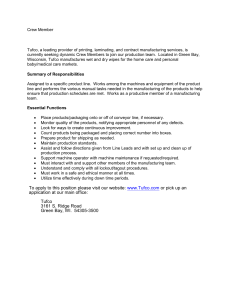
CONTROL OF HAZARDOUS ENERGY (LOCKOUT/TAGOUT) OSHA 29 C FR 1910-147 “This material was produced under grant numbers SH-22300-11-60-F-17 from the Occupational Safety and Health Administration, U.S. Department of Labor. It does not necessarily reflect the views or policies of the U.S. Department of Labor, nor does mention of trade names, commercial products, or organizations imply endorsement by the U.S. Government.” What is LOCKOUT/TAGOUT? • “Lockout/Tagout” refers to specific practices and procedures to safeguard employees from the unexpected energization or startup of machinery and equipment, or the release of hazardous energy during service or maintenance activities. • “Lockout” is the placement of a lockout device on an energy-isolating device, in accordance with an established procedure, ensuring that the energy-isolating device and the equipment being controlled cannot be operated until the lockout device is removed. • “Tagout” is the placement of a tagout device on an energyisolating device, in accordance with an established procedure, to indicate that the energy-isolating device and the equipment being controlled may not be operated until the tagout device is removed. • References: “OSHA Standard for the Control of Hazardous Energy (Lockout / Tagout)” 29 CFR 1910.147 and OSHA Publication 3120 “Control of Hazardous Energy – Lockout/Tagout” Lockout/Tagout Training Objectives: What is lockout/tagout. What is hazardous energy. Causes of fatalities/injuries. When lockout/tagout applies. Employer responsibility. Employee training. Lockout/tagout procedures required. Types of lockout devices. Requirement for tags. LOCKOUT/TAGOUT The OSHA Standard for the Control of Hazardous Energy (Lockout/Tagout) 29 CFR 1910.147 covers the servicing and maintenance of machines and equipment in which the unexpected start-up or the release of stored energy could cause injury to employees. What Does LOTO Require? • Lockout/Tagout requires, in part, that a designated individual turns off and disconnects the machinery or equipment from its energy sources(s) before performing service or maintenance and that the authorized employee(s) either lock or tag the energyisolating device(s) to prevent the release of hazardous energy and take steps to verify that the energy has been isolated effectively. • If the potential exists for the release of hazardous stored energy or for the reaccumulation of stored energy to a hazardous level, the employer must ensure that the employee(s) take steps to prevent injury that may result from the release of the stored energy. COMMONLY USED LOTO TERMS • • • • • • Affected Employee – An employee whose job requires him/her to operate or use a machine or equipment on which servicing or maintenance is being performed under lockout tagout. Authorized Employee – A person who locks out or tags out machines or equipment in order to perform servicing or maintenance on that machine or equipment. Energy Source – Any source of electrical, mechanical, hydraulic, pneumatic, chemical, thermal, or other energy. Lockout Device – Uses a positive means such as a lock to hold an energy isolating device in the safe position and prevent the energizing of a machine or equipment. Tagout Device – A prominent warning device which can be securely fastened to an energy-isolating device. Energy-Isolating Device – A mechanical device that physically prevents the transmission or release of energy. Lockout in General Industry Service and Maintenance Operations • The standard applies to the control of hazardous energy when employees are involved in service or maintenance activities such as constructing, installing, setting up, adjusting, inspecting, modifying, and maintaining or servicing machines or equipment. • These activities include lubricating, cleaning or unjamming machines, and making adjustments or tool changes, where the employees may be exposed to hazardous energy. Lockout in General Industry Service and Maintenance Operations (Cont.) • If a service or maintenance activity is part of the normal production operation, the employee performing the servicing may be subjected to hazards not normally associated with the production operation itself. • Workers performing service or maintenance activities during normal production operations must follow LOTO procedures if they: – Remove or bypass machine guards or other safety devices, – Place any part of their bodies in or near a machine’s point of operation, or – Place any part of their bodies in a danger zone associated with machine operations. EXCEPTIONS • The employee is performing work involving minor tool changes and adjustments or other minor servicing activities that are routine, repetitive, and integral to the use of the production equipment, that occur during normal production operations, and provided that the work is performed using alternative measures which provide effective protection. • Exposure to hazardous energy is controlled completely by unplugging the equipment from an electrical outlet and where the employee doing the service or maintenance has exclusive control of the plug. • An employee is performing hot-tap operations on pressurized pipelines that distribute gas, steam, water, or petroleum products, for which the employer shows the following: Continuity of service is essential; shutdown of the system is impractical; and the employee follows documented procedures and uses special equipment that provides proven, effective employee protection. Employers must establish a written energy-control program including: • Energy-control procedures for removing the energy supply from machines and for placing appropriate LOTO devices on the energy-isolating devices to prevent unexpected reenergization. • The training of employees on the energy-control program, including the safe application, use, and removal of energy controls. • A review of these procedures periodically (at least annually) to ensure that they are effective and being followed. What Employees Need to Know about LOTO “Authorized employees” • Hazardous energy source recognition • The type & magnitude of the hazardous energy sources in the workplace • Energy-control procedures, including the methods and means to isolate & control those energy sources “Affected employees” • Recognize when the energy-control procedure is being used • Understand the purpose of the procedure • Understand the importance of not tampering with lockout or tagout devices and not starting or using equipment that has been locked or tagged out “Other employees” • Must receive instruction regarding the energy-control procedure and the prohibition against removing a LOTO device and attempting to restart, reenergize, or operate the machinery • If tagout devices are used, all employees must receive training regarding the limitations of tags What is Hazardous Energy? Electricity – live or stored Mechanical - moving machine parts Hydraulic, pneumatic, or mechanical movement in machinery 3 What is Hazardous Energy? The Standard applies to all sources of energy, including but not limited to: Mechanical, electrical, hydraulic, pneumatic, chemical and thermal energy • Thermal Energy: Stored heat (steam lines or hot liquids) • Hydraulic Energy: Stored energy (steam or hydraulic fluid) • Chemicals in pipelines under pressure or force of gravity • Any other active or stored energy sources that could harm a worker 4 Hazardous Energy Source Examples Live electrical lines Electrical capacitors Lasers Hydraulic lifts Pneumatic (air pressure) lines Springs What kind of injuries can happen? • Shock or electrocution from live parts • Scalding from steam or hot liquids • Chemical burns or poisoning • From machinery: - Deep cuts and gashes - Crushing injuries - Amputations Fatalities & Injuries Causes for injuries: • • • • • Failure to stop equipment Failure to disconnect the power source Failure to dissipate residual (stored) energy Accidental restarting of equipment Failure to clean work area before reactivation Fatality Example A man working inside a supermarket cardboard compactor was crushed when the unblocked compactor suddenly came down on top of him Discussion Point: Are you aware of any fatalities? When is Lockout / Tag-out required? When someone will be servicing or repairing machinery or equipment and the unexpected machinery start-up or release of stored energy could cause injury LOTO vs. Machine Guarding Machine guarding protects the operator from the hazards of the machine while under NORMAL operating conditions. Lockout / Tagout refers to a practice to safeguard employees from the unexpected energization or startup of machinery and equipment, or the release of hazardous energy during service or maintenance activities. Lockout devices hold energyisolation devices in a safe or “off” position. They provide protection by preventing machines or equipment from becoming energized because they are locked out and no one can remove the lock without a key or other unlocking mechanism such as bolt cutters. Service and Maintenance Examples • Installing, constructing, • Adjusting, modifying, • Unjamming, cleaning, • Lubrication, inspecting, • Setup - preparing for normal function, Including die changes These activities often require a worker to place all or part of their body into the machine’s hazard zone. What is an energy-isolating device? A device that physically prevents transmission or the release of energy. Circuit Breaker Pipeline Valve Machine Block Anything else that positively blocks or isolates energy. What is a Lockout Device? A device that positively prevents a machine from being: started up turned on machinery parts from moving becoming electrically energized blocks a pipeline, steam line or air line. Electrical Lockout Devices Locked out circuit breaker Locked out electrical panel Locked out electrical plug Fluid & Gas Lockout Devices Pipe Lockout Examples Pneumatic Lockout Examples 17 Physical Blocks Punch Press Block Group Lockout Devices •Used when more than one person doing maintenance or repair on same machine or equipment. •Machinery or equipment can’t be started up until all locks are removed. •Each person places and removes their own lock. Example of a bad lockout/tagout What is Tag-out? Tags are warning devices only • They don’t provide the same physical restraint or level of protection as lockout devices. • Tags may evoke a false sense of security • They can only be removed by an authorized person. • They must be legible, securely attached and resistant to degradation. Requirements for LOTO Devices • The employer must provide these devices and they must be singularly identified and not used for other purposes. • They must be durable enough to withstand workplace conditions; • Standardized enough to minimize the likelihood of premature or accidently removal; and • Labeled to identify the specific employees authorized to apply and remove them. ENERGY-CONTROL PROCEDURES MUST: Outline the scope, purpose, authorization, rules and techniques that employees will use to control hazardous energy sources, as well as the means that will be used to enforce compliance. These procedures must provide employees at least the following information: • A statement on how to use the procedures • Specific procedural steps to shut down, isolate, block, and secure machines • Specific steps designating the safe placement, removal and transfer of LOTO devices and identifying who has responsibility for the LOTO devices • Specific requirements for testing machines to determine & verify the effectiveness of LOTO devices and other energy-control measures TYPICAL MINIMAL LOCKOUT SHUTDOWN PROCEDURES REQUIRE WORKERS TO: • Prepare for shutdown • Shut down the machine • Disconnect or isolate the machine from the energy source(s) • Apply the lockout or tagout device(s) to the energyisolating device(s) • Release, restrain or otherwise render safe all potential hazardous stored or residual energy • Verify the isolation & deenergization of the machine Lockout Procedures Six Steps to Follow: 1. Notify affected employees that machine or equipment will be shut down and locked out 2. Shut down the machinery or equipment 3. Isolate energy sources with energy-isolating devices 4. Lock out energy-isolating devices with assigned locks. 5. Release or restrain stored or residual energy 6. Test machinery to make sure it can’t start up Lockout Steps Notify employees Shutdown Equipment Isolate Energy Attach Lockout Device Release Stored Energy Verify Lockout Service & Maintenance Example: Release of Stored Energy • Pressurized Vessel - “Slowly open the receiver tank port and bleed off any internal pressure.” • Pressurized Piping - “Loosen both line valves to relieve all pressure in the cooling circuit.” • Electrical Capacitor - “Ground out capacitor…” VERIFY EQUIPMENT IS DE-ENERGIZED Example: Attempt to Operate • “…adjust the temperature cycle thermostat to check that all electrical energies have been shut off.” • “Push the start function button to verify that electric power has been removed.” • “Crack the steam inlet and discharge line outlet valves…” WHAT DO I DO IF I CANNOT LOCK OUT THE EQUIPMENT? • If the energy-isolating device associated with the machinery cannot be locked out, you must securely fasten a tagout device as close as safely possible to the energyisolating device in a position where it will be immediately obvious to anyone attempting to operate the device. • You also must meet all of the tagout provisions of the standard. • The tag alerts employees to the hazard of reenergization and states that employees may not operate the machinery to which it is attached until the tag is removed in accordance with an established procedure. TYPICAL MINIMAL LOCKOUT STARTUP PROCEDURES REQUIRE WORKERS TO: • Before removing LOTO devices, the employees must take the following steps in accordance with the specific provisions of the employer’s energy-control program: • Inspect machines or their components to assure that they are operational intact and that nonessential items are removed from the area; and • Check to assure that everyone is positioned safely and away from machines. • After removing the lockout or tagout devices but before reenergizing the machine, the employer must assure that all employees who operate or work with the machine, as well as those in the area where service or maintenance is performed, know that the devices have been removed and that the machine is capable of being reenergized. Start-up Procedures Only authorized employee can do startup 1. All warned to stay clear 2. Remove all tools, locks and tags 3. Remove, reverse, open or reactivate isolating devices 4. Visual check that all is clear 5. Start up machine, process or line flow




